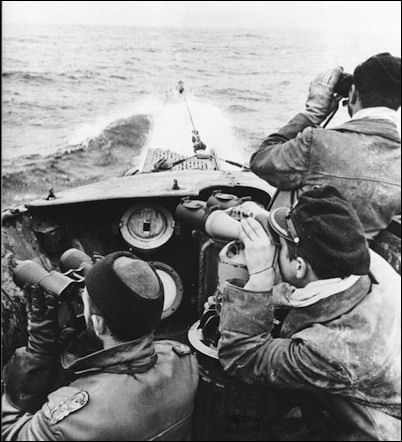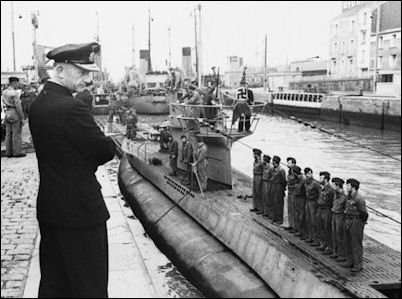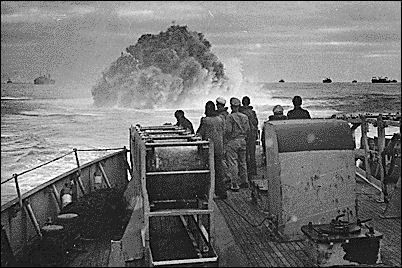![]()

Battle of the Atlantic
When all was said and done, British Prime Minister, Winston Churchill, would comment, “The only thing that ever really frightened me during the war was the U-boat peril. I was even more anxious about this battle than I had been about the glorious air fight called the Battle of Britain.”
For a time, the danger had existed that Great Britain might fall without a single German soldier setting foot on the island nation. Rather, it would be strangled into submission at sea, deprived of the life giving food, raw materials and oil which flowed into its ports, causing perhaps millions to perish.
Interestingly, the whole scenario had played out once before. Just over two decades earlier, during the First World War, newly invented German subs had tried to sever the lifeline to North America and break the British Navy's blockade of Germany. Many of the German sub commanders in World War II were veterans of that prior battle of the Atlantic as were most of the British Naval commanders. Back then, the British had learned through hard experience that the best defense was to avoid letting ships sail alone, relying instead on the safety of protected convoys. But the Germans had learned as well and developed an effective new counter-measure which they used from September 1939 onward – the submarine wolf pack.
When a convoy was spotted, radio signals were sent to all nearby subs to assemble and line up to intercept the oncoming ships. They waited for darkness then attacked all at once while weaving through the convoy. The diesel-powered subs could dash along the surface at 20 miles-per-hour. Their low profiles against the horizon made them very difficult to spot at night. At the same time, the taller merchant ships were easy for the sub crews to see, making them very good targets.
For Admiral Karl Dönitz, leader of Germany's U-boat fleet, the only hindrance to success was the limited number of subs in service. He had wanted 300 U-boats ready by the onset of war, a number he considered sufficient to cut off Britain from the outside world. But when the war began only 57 U-boats were actually in service. Hitler had been skeptical about the strategic potential of sub warfare and had given little priority to the sub fleet during his prewar arms buildup, adding several super-sized battleships instead. Not to be outdone, Dönitz hoped to convince Hitler to enlarge the sub fleet by achieving great results early on.
The first such deed to attract Hitler's attention was the spectacular sinking of the British Battleship HMS Royal Oak by U-47 in October 1939. The U-boat had managed to silently slip into the Royal Navy base at Scapa Flow and torpedoed Royal Oak while it was anchored, causing it to capsize with the loss of 833 men. Upon returning home, U-47's commander was presented to Hitler for congratulations while Nazi propaganda played up the triumph over Germany's traditional naval foe.
Dönitz kept the momentum going, making good use of his limited resources while benefiting from the high morale of his elite sub crews. Upon the fall of France in June 1940, Dönitz relocated his sub bases to France's northern coast, making it much easier for his wolf packs to reach the mid-Atlantic, where the British convoys were most vulnerable. By late December 1940, nearly five million tons of merchant shipping, over a thousand ships, had been sunk by wolf packs with minimal losses to the U-boat fleet, while some 6,000 merchant seamen had been killed.
The U-boats were further aided when German Naval intelligence broke the Royal Navy's radio communication code, providing precise information on British convoy movements and the numbers of ships and escorts, thereby giving wolf pack commanders at sea a powerful advantage. At the same time, the Royal Navy was slow to coordinate its anti-sub efforts with the Royal Air Force to track down the wolf packs, while British code breakers were unable to decipher German radio messages employing a newly improved coding scheme. And so, for a time, the U-boats had free range.
However, in spite of the ever-present danger, British, Canadian and American sailors and merchant seamen sailed the stormy seas to keep the lifelines to North America open, knowing they might be torpedoed without warning at any moment. An American ensign recalled being struck while standing on the deck of a freighter bound for England: "I became fascinated by the artificial torpedo tracks of moonlight and white water. I was not surprised when we were hit, for suddenly I saw, deep under the surface, two streaks of greasy light, parallel, moving fast, coming in at an angle. There was no time to shout a warning; in one instant there were the tracks; in another a great shattering crash."
When a ship was hit by torpedoes, hundreds of men drowned in the bone-chilling Atlantic or burned to death in floating pools of flaming gasoline. Others were left bobbing helplessly in life jackets, as convoy regulations strictly prohibited merchant ships from stopping to help.
A U-boat crew's only concern upon sinking a ship was to note its tonnage so the figure could be added to the list at Naval headquarters and duly reported to the Führer. By mid-1942, that number had swollen to 700,000 tons, or about 160 ships, sunk every month. This meant the Germans were sinking Allied ships faster than they could be built, including numerous American merchant ships and tankers along the sparsely defended U.S. East Coast.
For Dönitz, success of this magnitude had huge rewards. In March of 1943, Hitler appointed him as the new Chief of the German Navy and put a 400-strong U-boat fleet at his disposal. This allowed Dönitz to effectively block the Atlantic shipping lanes and left Britain nearly severed from North America. Churchill's naval nightmare was about to come true, so it seemed.
But fortunately for the British people, Allied technicians had been working hard behind the scenes, while Royal Navy and Air Force crews underwent intensive training to better coordinate their anti-sub efforts. A major break came when newly invented long-range radar devices were installed on British bombers, allowing them to pinpoint the far off positions of U-boats traveling along the surface, where they spent most of their time. Once detected, the bombers dropped depth charges and attacked with new rocket-propelled explosives. Radar-equipped American B-24 bombers also roared into the air from British land bases, while fast-moving British and American destroyers, now equipped with radar as well, blasted the U-boats with 300-pound depth charges.
The radar technique proved so effective that Dönitz wondered if a German traitor in his midst was somehow relaying the exact position of his subs to the Allies. Worse for Dönitz, newly improved sound detection technology allowed Allied warships to locate radio signals from distant wolf packs and organize surprise attacks. Additionally, the perilous mid-Atlantic crossing became safer after American aircraft carriers began escorting the convoys and launched fighter planes equipped with large caliber machine-guns to strafe and sink U-boats lurking nearby.
By comparison, German sub technology and wolf pack tactics had stagnated amid a complete lack of cooperation from Göring's Luftwaffe. As a result, the predictable wolf packs began to suffer heavy losses every time they attacked, causing morale to plummet amid a 75-percent casualty rate. The turning point in the sea battle occurred in May 1943, when 41 subs were lost, compelling Dönitz, whose youngest son was killed in a sub that month, to withdraw his U-boats from the North Atlantic.
However, when Dönitz met with the Führer to discuss the whole situation, Hitler told him, "There can be no question whatever of letting up in the U-boat war. The Atlantic is my western buffer zone..." Dönitz therefore sent the wolf packs back to the North Atlantic in the autumn of 1943, only to have his U-boats sunk at an even greater rate – one sub for every ship attacked – a truly unsustainable casualty rate. And so Dönitz withdrew again from the North Atlantic, this time permanently, leaving the shipping lanes wide open. Britain's lifeline to North America was thus restored.
Hitler had lost the Battle of the Atlantic, due the perseverance of individual sailors and merchant seamen who kept the ships moving no matter what, along with improved coordination between the British Navy and Air Force, and technological developments that tipped the scales in favor of the Allies. Additionally, American shipyards along the East Coast began turning out new merchant ships at an astounding rate, soon replacing all of the lost tonnage.
The British people would now receive all of the supplies they needed, along with a gigantic arsenal of American-made weapons, ready to be used for the invasion of northern Europe.
In the meantime, Hitler was still obsessed with achieving victory in Russia. He decided to make one last gamble on the Eastern Front, throwing everything into a gigantic attack at Kursk, a place that few people outside of Russia ever heard of – but would henceforth become known as the setting for the greatest tank battle ever fought.
Copyright © 2010 The History Place™ All Rights Reserved
![]()
NEXT SECTION - The Kursk Gamble
The Defeat of Hitler Index
The History Place Main Index Page
Terms of use: Private home/school non-commercial, non-Internet re-usage only is allowed of any text, graphics, photos, audio clips, other electronic files or materials from The History Place.



